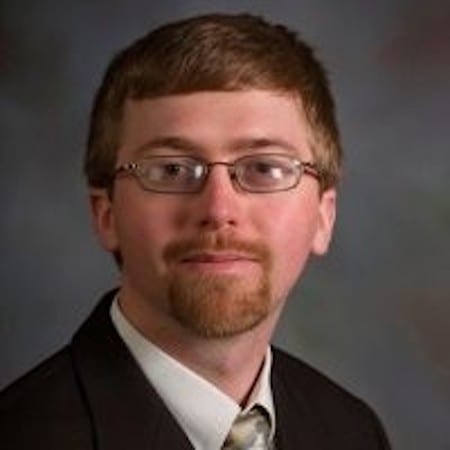
Dr. Jacob Moore
PSU Mont Alto
Jacob Moore is an assistant professor of engineering. He teaches a variety of engineering courses at Penn State Mont Alto, including Introduction to Engineering Design and Graphics, Statics, Dynamics, Strength of Materials, and Thermodynamics. He also runs the engineering lab on the Mont Alto campus.
Education:
B.S., Rensselaer Polytechnic Institute, 2008
M.Eng., Virginia Polytechnic Institute, Mechanical Engineering, 2012
Ph.D., Virginia Polytechnic Institute, Engineering Education, 2013
Research Interests:
Engineering education with a focus on digital textbooks, additive manufacturing technologies
Project Details
Mechanical Engineering 212 Authoring Project
Course Goals:
Acquire a working knowledge of vector calculus and to apply it to the description of kinetic and kinematic quantities such as forces, moments, position, velocity, and acceleration. Apply calculus to correctly relate position, velocity, and acceleration to one another. Model mechanical systems by drawing free body diagrams of particles and rigid bodies and then by writing the governing equations of motion. These models may be applicable at either a specific instant in time and/or point in space or they may be applicable over a range of time and space. Apply algebra, calculus, and elementary differential equations (usually through the use of computer software), to the solution of the equations of motion. Apply the work-energy principle to relate the energy of a mechanical system to its spatial configuration variables (i.e., position variables). Apply the impulse-momentum principle to relate the momentum of a mechanical system to the system of forces applied to it. Learn appropriate physical and mathematical assumptions, and begin to develop the analytical capability necessary for tackling a wide variety of engineering problems.
Course Objectives:
Upon successfully completing this course students will be able to…
- Apply mathematical principles (algebra, trigonometry, and calculus) to relate position, velocity, and acceleration to one another in different co-ordinate systems.
- Create free body diagrams (FBD) of particles and rigid bodies.
- Apply mathematical principles to the solution of the equations of motion, i.e. particle kinetics.
- Solve problems using the work done by a force and apply the work-energy principle to relate the kinetic energy of a system to its position variables.
- Apply the impulse-momentum principle to relate the change of linear and angular momentum of a mechanical system to the system of linear and angular impulse applied to it.
- Identify and solve problems involving the impact of particles.
- Apply rigid body kinematics to solve problems.
- Apply mathematical principles to the solution of equations of rigid body motion, i.e. rigid body kinetics.
- Apply fundamental work-energy and impulse-momentum principles to rigid body kinetics.
Proposal Plan:
“Overall I intend to have an open textbook covering the entirety of the EMCH 212 course, including written explanations, video lectures, worked problems (with written and video solutions) and homework problems. This is broken down into 5 chapters that would be appended to my existing open statics textbook on a server at (adaptivemap.psu.edu). In round 1 of the ACT@PSU grant I had intended to deliver all five chapters with at least written solutions and homework problems with solutions. As of the end of December 2018 I will have all homework problems with solutions complete along with two chapters of the content. A good amount of work was also put into improving the technical aspects of the website and how it is structured. I had underestimated the time required to develop the content and have made adjustments for this additional round. I have recruited other EMCH 212 instructors from across the Commonwealth Campuses to help with development and will be stepping back from the MC-REU program this summer if the proposal is accepted to devote more time to this project. For this new round me and my co-authors will finish content for the next three chapters, in addition to building up the worked examples (as students have identified these as being the most important component of the textbook), with video lectures, and video solutions to support the content. The additional instructors will also be used to edit and refine the existing content in both the statics and dynamics course.”